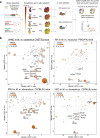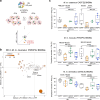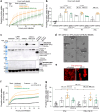GRA12 is a common virulence factor across Toxoplasma gondii strains and mouse subspecies
- PMID: 40240328
- PMCID: PMC12003902
- DOI: 10.1038/s41467-025-58876-2
GRA12 is a common virulence factor across Toxoplasma gondii strains and mouse subspecies
Abstract
Toxoplasma gondii parasites exhibit extraordinary host promiscuity owing to over 250 putative secreted proteins that disrupt host cell functions, enabling parasite persistence. However, most of the known effector proteins are specific to Toxoplasma genotypes or hosts. To identify virulence factors that function across different parasite isolates and mouse strains that differ in susceptibility to infection, we performed systematic pooled in vivo CRISPR-Cas9 screens targeting the Toxoplasma secretome. We identified several proteins required for infection across parasite strains and mouse species, of which the dense granule protein 12 (GRA12) emerged as the most important effector protein during acute infection. GRA12 deletion in IFNγ-activated macrophages results in collapsed parasitophorous vacuoles and increased host cell necrosis, which is partially rescued by inhibiting early parasite egress. GRA12 orthologues from related coccidian parasites, including Neospora caninum and Hammondia hammondi, complement TgΔGRA12 in vitro, suggesting a common mechanism of protection from immune clearance by their hosts.
© 2025. The Author(s).
Conflict of interest statement
Competing interests: The authors declare no competing interests.
Figures






References
-
- Pappas, G., Roussos, N. & Falagas, M. E. Toxoplasmosis snapshots: global status of Toxoplasma gondii seroprevalence and implications for pregnancy and congenital toxoplasmosis. Int. J. Parasitol.39, 1385–1394 (2009). - PubMed
-
- Howe, D. K. & Sibley, L. D. Toxoplasma gondii comprises three clonal lineages: correlation of parasite genotype with human disease. J. Infect. Dis.172, 1561–1566 (1995). - PubMed
-
- Grigg, M. E., Ganatra, J., Boothroyd, J. C. & Margolis, T. P. Unusual abundance of atypical strains associated with human ocular toxoplasmosis. J. Infect. Dis.184, 633–639 (2001). - PubMed
MeSH terms
Substances
Grants and funding
- WGF2024-0027/Wenner-Gren Foundation (Wenner-Gren Foundation for Anthropological Research, Inc.)
- TO 1349/1-1/Deutsche Forschungsgemeinschaft (German Research Foundation)
- CC2132/WT_/Wellcome Trust/United Kingdom
- CR2132/Francis Crick Institute (Francis Crick Institute Limited)
- CR2023/030/2132/Francis Crick Institute (Francis Crick Institute Limited)
LinkOut - more resources
Full Text Sources

